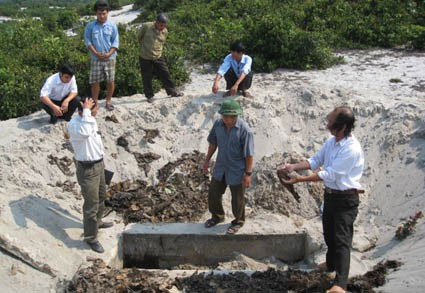Many unique features in Cao Phuong ancient tomb
Excavating an ancient tomb dating back to the 17th century in the late Le Dynasty revealed in early April during the construction of the road under the Bao Minh Industrial Park project at Dau Dinh field (Cao Phuong village, Lien Bao commune). In Vu Ban district, Nam Dinh province , experts from Vietnam Archaeological Association and Nam Dinh Museum have discovered many special points of archeological value.
>>>The secret of the ancient tombs was unearthed in Vietnam
According to the initial research results, the Associate Professor and Doctor Nguyen Lan Cuong, Deputy General Secretary of Vietnam Archeology Society, on behalf of the excavation team at the Conference "New discoveries on archeology in 2011 " organized by the Archaeological Institute on September 29 in Hanoi, it can be affirmed that the compound in Cao Phuong is a very unique discovery.
This grave is the smallest compound in Vietnam, which has been discovered in Vietnam so far and is also the first time in Vietnam there is a grave structure like a compound but used for rebuilding purposes.
Specifically, Cao Phuong ancient tomb has a compound made of compound (likely to be made of honey, sand, lime and charcoal), 6.3cm thick, surrounded by an intact black wooden coffin (most likely wood Ngoc am) has the size of 94.5x27.3x33.4 cm, as small as half or 1/3 of the coffins in the ancient tombs previously excavated.

Excavation of ancient tombs
The coffin is matched with the coffin lid with 4 small wooden pegs matching the dream at the top, completely without metal nails to lock the grave as is common in other compound graves.
The artifacts in the coffin include a yellowish brown cloth that has been soaked and wet with oil covering the entire physical dimension, a skull covered with a piece of paper. The set of intact teeth 32 are all black.
Under the neck there are two semicircular clay pieces. The bones under the skull are intact, lined up parallel and close together. Look at the joint on the skull, the wear of the teeth and based on the large defect of the pelvis, it can be confirmed that this is the core of a man about 40-45 years old.
It is especially important that the excavation team has discovered 8 hair fibers that are still attached to the lower jaw and the lower skull.
According to Associate Professor-Doctor Nguyen Lan Cuong, maybe when this man died, his relatives kept some hair to be buried in the same burial place, just as if they were buried under good teeth. Nails and toenails of the deceased are often seen in other mummies.
Another special feature of Cao Phuong ancient tomb is the embalming of an essential oil for a skeleton. Before that, in Vietnam, it was never discovered that embalming an oil of a skeleton, placed in a wooden coffin, just like this one.
The archaeological team took samples of the essential oil in time for analysis - it was necessary that no excavation of any compound could be done because the grave was often destroyed before the scientists were informed. At that time, rainwater or underground water was absorbed.
In addition, around the area where the compound was discovered, the experts of Nam Dinh Museum surveyed and collected 46 ceramic and crockery artifacts of many historical periods such as the Dong Son culture (the century). 4-5 BC, in the Han Dynasty (1-3th century AD), during the Tran dynasty (13-14 century), during the Le So period (15th century), in the late Le Dynasty (17-18 century) ) and the Nguyen Dynasty (19th century).
According to Mr. Nguyen Van Thu, Director of Nam Dinh Museum, the excavation team is now continuing to study the detailed problems of Cao Phuong ancient tomb and conducting the examination of objects . to complete the report. science in accordance with the regulations stated in the excavation permit.
Particularly, the coffin has been brought to the exhibition by Nam Dinh Museum because this is the smallest "coffin" in Vietnam since ancient times.
- The skeleton of the ancient tomb of War Kingdom disappeared mysteriously
- The secret of an ancient tomb is 800 years old in China
- Close to the ancient tomb discovered in Saigon
- The ancient tomb of Quan stood at the top of Cho Lon when it was built in Saigon
- Again discovered the ancient tomb at Ciputra
- The mysterious 'monster' dies with the girl in Maya's tomb
- Stunned discovery in ancient tomb 'human soup' in Egypt
- Royal treasure in Luu Phi Tomb
- The ancient Egyptian tomb may contain the forgotten pharaoh's corpse
- Mysterious world largest tomb in ancient China
- Identify the Egyptian pharaoh in the ancient tomb
- Discovered the silver crown in the ancient tomb from the Bronze Age
 Discovered an ancient centipede fossil 99 million years old
Discovered an ancient centipede fossil 99 million years old Discovered bat-like dinosaurs in China
Discovered bat-like dinosaurs in China Discovered a 200-year-old bronze cannon of the coast
Discovered a 200-year-old bronze cannon of the coast Discover 305 million-year-old spider fossils
Discover 305 million-year-old spider fossils